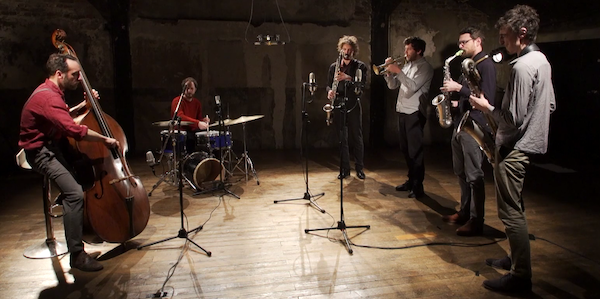Apr 2, 2024 12:59 PM
Saxophonist, Sonic Explorer Casey Benjamin Dies at 45
Casey Benjamin, the alto saxophonist, vocalist, keyboardist and producer who stamped his distinctive sounds on the…

Band Housing was among the performers at the Parisian Sons d’hiver festival, which ran Jan. 17–Feb. 8.
(Photo: Courtesy Sons d'hiver)Sons d’hiver, the two-week music event that takes place in the suburbs south of Paris each winter, “is not a jazz festival,” according to director Fabien Simon.
Jazz and improvised music might provide the festival’s “spinal cord or main axis,” he said, but the aim is to showcase music outside fixed genre categories—with a cross-cultural emphasis.
“One night we showcase Turkish music, another night it’s Brazilian music,” Simon continued. “The idea is to have shows never before seen in France that are entirely new.”
This year, many of the highlights fell within this remit: the affecting performance by vocalist/composer Wu Fei (guzheng) and Shanir Ezra Blumenkranz (oud/bass) evoked the Jewish émigré experience in 1930s Shanghai; and Abdullah Miniawy’s “cry from Cairo,” transported listeners back to the mood of 2011’s Tahrir Square uprising.
The ensemble Band Housing has covered well-known compositions by Monk and Gillespie, and the lesser-known Boots Mussulli, Annie Rose and Jack Montrose. But the band took on compositions by a different musician during the festival.
“Our motivation in playing Randy Weston’s music is that it’s music seldom played,” said Louis Laurain, Band Housing’s trumpeter, when asked about the revival of the composer’s music, sans piano. “Weston is not underrated, but not that well known outside a few tunes, such as ‘Hi-Fly.’ There’s a lot to work with.”
The six-piece ensemble, which holds a bar residency in a West African neighborhood in Paris, played the the opening slot for Brazilian legend Hermeto Pascoal. The composer and multi-instrumentalist was abetted by a team of energetic musicians showing their virtuosity in a performance that bordered on vaudevillian at times, with players decked out in aprons, Pascoal saluting the audience, glass of red wine in hand.
A different Franco-American celebration was at the heart of this year’s festival: the 50th anniversary of The Art Ensemble of Chicago, which decamped to the French capital in the late 1960s. Composer/reedist Roscoe Mitchell and percussionist Famoudou Don Moye presented a midweek seminar, and then performed with a 14-piece ensemble that included spoken word from Moor Mother, during the festival’s final weekend.
“What’s up Paris? How you doing?” asked Brooklyn-based trumpeter Jaimie Branch, who sauntered onto the stage, dressed in a baseball cap and silk jacket, launching into a set marked by precision and force, with excellent support from drummer Chad Taylor, bassist Jason Ajemian and cellist Lester St. Louis. Pieces from Fly Or Die II were transformed into dramatic vignettes, trumpet lines fragmenting and tossed forward amid various effects.
In 2016, drummer Andrew Cyrille, trumpeter Enrico Rava and bassist William Parker dedicated a performance to Cecil Taylor at New York’s Whitney Museum of American Art. They reunited once more for a set honoring his memory at Sons D’Hiver. Parker has a longstanding association with the festival, now in its 29th year, said Simon. When he asked Cyrille and Parker to propose ideas, they suggested this tribute.
“What’s important for us is to create a link [between eras]; we can adopt here one of the doctrines of The Art Ensemble of Chicago—ancient to the future,” Simon said, discussing the theme of remembrance that ran through this year’s program. “[Sons d’hiver can] create a link between the history of music, what is happening today and what might be music of the future.”
Watching the three performers improvise together—no solos, no stopping for applause and no incidental talk—was proof of that. DB

Benjamin possessed a fluid, round sound on the alto saxophone, and he was often most recognizable by the layers of electronic effects that he put onto the instrument.
Apr 2, 2024 12:59 PM
Casey Benjamin, the alto saxophonist, vocalist, keyboardist and producer who stamped his distinctive sounds on the…

“He’s constructing intelligent musical sentences that connect seamlessly, which is the most important part of linear playing,” Charles McPherson said of alto saxophonist Sonny Red.
Feb 27, 2024 1:40 PM
“I might not have felt this way 30 to 40 years ago, but I’ve reached a point where I can hear value in what people…

Albert “Tootie” Heath (1935–2024) followed in the tradition of drummer Kenny Clarke, his idol.
Apr 5, 2024 10:28 AM
Albert “Tootie” Heath, a drummer of impeccable taste and time who was the youngest of three jazz-legend brothers…

“Both of us are quite grounded in the craft, the tradition and the harmonic sense,” Rosenwinkel said of his experience playing with Allen. “Yet I felt we shared something mystical as well.”
Mar 12, 2024 11:42 AM
“There are a few musicians you hear where, as somebody once said, the molecules in the room change. Geri was one of…

Larry Goldings’ versatility keeps him in high demand as a leader, collaborator and sideman.
Feb 21, 2024 10:45 AM
Are you having any fun? Larry Goldings certainly is. Consider just two recent examples:
Scene 1: “If anyone had…